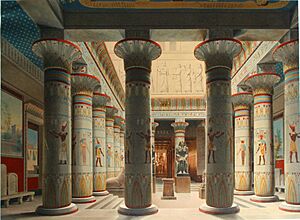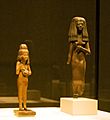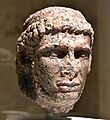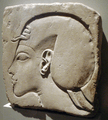Egyptian Museum of Berlin facts for kids
 |
|
| Location | Museum Island, Berlin |
|---|---|
The Egyptian Museum and Papyrus Collection of Berlin (German: Ägyptisches Museum und Papyrussammlung) is a fantastic place to explore ancient Egypt! It holds one of the world's most important collections of old Egyptian artifacts. This includes the famous Nefertiti Bust. Since 1855, this amazing collection has been part of the Neues Museum. The museum is located on Berlin's Museum Island. It reopened in 2009 after being carefully renovated.
Contents
History of the Museum
How the Collection Started
The museum's story began in the 1700s. It grew from the royal art collection of the Hohenzollern kings of Prussia. A famous explorer named Alexander von Humboldt suggested creating an Egyptian section. So, the first Egyptian objects arrived in Berlin in 1828. This happened during the time of King Frederick William III of Prussia.
At first, the collection was kept in Monbijou Palace. A merchant from Trieste, Giuseppe Passalacqua, was in charge. His large collection formed the base of the museum. Later, a Prussian trip to Egypt and Nubia brought even more items to Berlin. This trip was led by Karl Richard Lepsius between 1842 and 1845.
Moving and Reuniting the Collection
In 1850, the collection moved to its current home. This was the Neues Museum, designed by Friedrich August Stüler. The Nefertiti Bust was found during excavations in Amarna. An entrepreneur named Henri James Simon gave it to the museum in 1920. It quickly became the museum's most famous item.
After World War II, the Neues Museum was badly damaged. The collection was then split between East Berlin and West Berlin. The main part stayed in East Berlin and was shown at the Bode Museum. The items sent to West Germany, including the Nefertiti Bust, returned to West Berlin. From 1967 to 2005, these items were displayed near Charlottenburg Palace.
After Germany became one country again, the whole collection was reunited. It returned to Museum Island, where it belongs.
What You Can See
Famous Artifacts
The museum's collection includes artifacts from a very long time ago. Some pieces date back to 4000 BC, which is the Predynastic era. Others are from the time of Roman rule. However, most items are from the rule of Akhenaten, around 1340 BC.
The most famous piece is the bust of Queen Nefertiti. It is incredibly well-preserved and still has its bright colors. The collection moved from Charlottenburg to the Altes Museum in 2005. Then, in October 2009, it was moved into the newly rebuilt Neues Museum on Berlin's Museum Island.
Studying Mummies
The museum is also home to at least 23 mummified ancient Egyptians. In the 2020s, scientists performed CT scans on these mummies. This was part of a study to learn more about how hearts were mummified. The CT scans also helped researchers try to figure out if the mummified people were male or female. They also tried to find out how old they were when they died.
Gallery
-
Tai-tai, the Priest. New Kingdom, Eighteenth Dynasty, 1380 BC
-
Akhenaten and Nefertiti with their children. Amarna Period, 1350 BC
-
Queen Tiye, Amarna Period, 1355 BC
See also
 In Spanish: Museo Egipcio de Berlín para niños
In Spanish: Museo Egipcio de Berlín para niños
- List of museums of Egyptian antiquities












